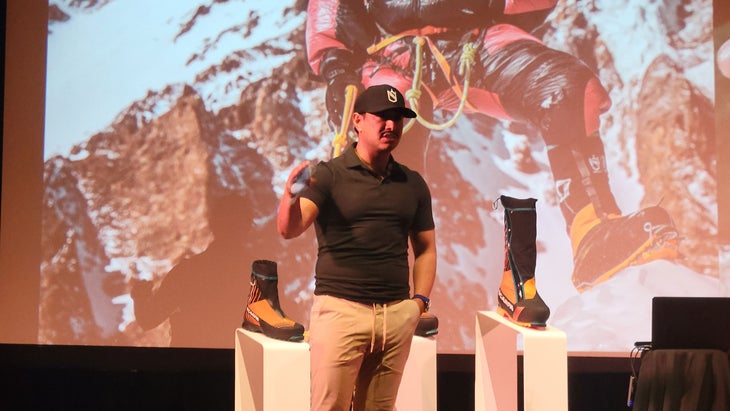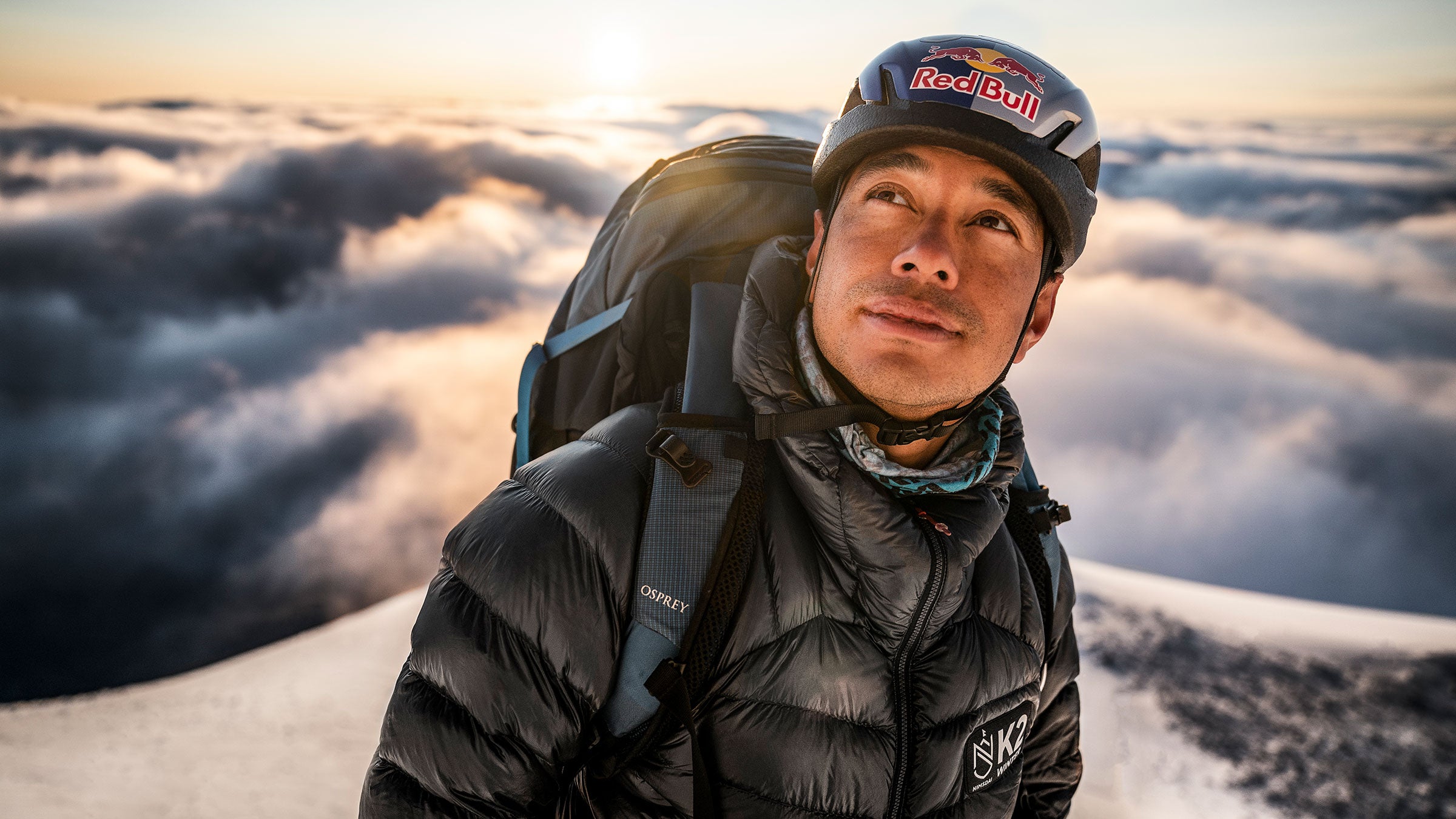Nepalese climber Nirmal “Nims” Purja wears many hats these days: mountaineer, , , and even motivational speaker. Last week, Purja, 39, traveled from his home in Kathmandu to Boulder, Colorado, to address a crowd of fans at an event organized by his boot sponsor, Scarpa. Purja retold the story of breaking the speed record on the 14 peaks above 8,000 meters, and then shared some of the insight he gleaned from the expedition. That mission, called Project Possible, birthed the 2021 Netflix documentary , which made Purja a global icon.
We sat down with Purja prior to the event to discuss—among other things—his challenging 2022 season, which brought him both triumph and tragedy.
OUTSIDE: We saw multiple climbers chase on the 8,000-meter peaks this year. What’s your reaction to the uptick in speed climbs on these mountains?
NIMS PURJA: It’s amazing, because if it wasn’t for the 14 Peaks this wouldn’t be happening. So, I take a lot of pride in this happening, because, you know, was about breaking records and showing the world at what could be done. Now, I tell everyone: My record needs to be broken. Breaking it will be evidence of us as human beings progressing at climbing these mountains. When the first four-minute mile was done, that became the milestone, and then others did it much faster. If somebody breaks my record, I will be there to shake their hand.

What advice have record-chasing mountaineers sought from you?
People didn’t really ask for my advice, I think it was more that they followed the way I approached the climbs because it is a proven concept now. They know which mountains to climb in the schedule: Annapurna, Dhaulagiri, Everest, Lhotse, and so on.
Let’s say you had access to the funding, helicopters, and permits to enter China. What’s the fastest that you could climb the 14 peaks?
For me, I can climb all 14 without oxygen in four months. But that’s not my goal anymore. If people want to do it to achieve the new possible—their possible, not my possible—it is feasible. If I put together a team of Sherpas, it could be done. Here’s the thing: at 8,000 meters, we are the best, there is no debate. If you ask me to go rock climb with Alex Honnold, there is no way I can be close to him. But if you go full-on bear-to-bear comparison on the 14 peaks, there is no competition. That’s what I proved on my winter expedition to K2. I climbed and executed that expedition where ten Nepalese climbers summited and nobody else did.
What’s your response to the criticism that chasing speed records on these mountains isn’t true alpinism?
Those people who are commenting that are limiting themselves. Before it was OK to climb quickly, but now it’s not OK? According to who and what rules? People have tried to climb Everest and Lhotse in a single push across that traverse. I have done that while guiding and leading 14 people on an expedition, and there were critics! You will always find pushback on these topics.
What about the criticism that chasing speed records is putting climbers in unnecessary danger?
I don’t agree with that because everything we do in these sports is dangerous. I do mountaineering and skydiving and paragliding, and I’m still climbing these mountains and leading the expedition from the front—not from base camp or from Kathmandu. There is always danger in what I am doing. It is up to the individual how to mitigate those risks, and the evolution of that comes down to how much experience, knowledge, and planning perspective that individual has.
In September, your guiding company, Elite Exped, suffered a tragedy when a . I realize this may be difficult, but I’m curious if you can discuss this event and the aftermath.��
That day I had just landed in Kathmandu around 6 P.M. and as I got into the hotel I got the news. At first I thought it was a small fire, but then I saw the full footage. Immediately I went to the scene. If there was a normal fire in the office, the guys would have been able to escape. People will always try to protect their life, but this fire happened so quickly. Accidents can happen and we are coordinating with the government to determine what happened. For me, I lost people who were like brothers. Ashok [Wenja Rai] was very close to me. He ran the whole operation at the office and the manager. Karsang [Tenjing Sherpa] is [Elite Exped co-founder] Mingma David’s own brother, and he died too. Karsang climbed with us on Dhaulagiri during Project Possible, and afterwards he had asked me if I could give him a job in Kathmandu. The third guy, Tsewang [Sherpa], was new to the company, and I had not met him. But the whole situation was very sad. I walked from [the office] to my house in tears the whole way. According to the law of Nepal, we do not have to pay anything, because it was declared an accident. But I said I will do whatever I can to help the families of these men. It is now not just one family I am looking out for, it is four. But that is the right thing to do.
The fire occurred during a tragic week on Manaslu, where multiple climbers died, including American ski mountaineer Hilaree Nelson.��
The day after the fire, I was dealing with it when I learned of the avalanche on Manaslu, and I stopped everything to help out with the rescue. We made that rescue happen—it was like a full-on military operation. Once I finished that operation I got to Kathmandu and Jimmy Chin texted me: ‘Hilaree [Nelson] got caught in it. Is there any chance you can help?’ I was at basecamp earlier in the month and met Jim Morrison and Hilaree then. When I got the text I was like OK, I will do what I can. Jimmy is very close to me, and he helped make Project Possible happen. So at that moment I was dealing with the fire in Kathmandu—I went to the hospital with one of the survivors and was dealing with his family. Then I planned the rescue with Mingma David. He was the ground commander. They went to bring Hilaree back. All of these things were happening at the same time. It was a very difficult few days.
What was your assessment of the danger on Manaslu this year? There were a on the mountain, and some hypothesized that the crowding added to the tragedy.��
It was heavy snow for sure. We were in charge of fixing the ropes and we fixed it early, there were a few summits, but it was an abnormal season. It was a difficult season, but it had nothing to do with the number of people. If you look at Mont Blanc there will be more than 5,000 climbers a year, and Manaslu it’s 600 or 700, and that is nothing. That’s why we set ropes so early, so that people can climb at their own pace. I think the monsoon didn’t finish in the first week of September like normal, and that is what created problems.
Just a few weeks later you were involved in a that claimed the life of your instructor, Dean Waldo. What do you recall from that event?
It was a pure accident. Dean was a super experienced guy. That day he decided to do something he shouldn’t have been doing: he tried to come and stand on top of my canopy. I had a bigger canopy than his, and his canopy collapsed and he fell through mine. I waited to see what was going to happen and we went into a spiral lock and somehow he had my canopy in his face and he couldn’t get out. I had to cut away because we were losing altitude, but he was trapped. His friends told me that he had [[experienced]] hundreds of situations like this, and that he had crashed harder than this one. But the angle at which he crashed, he died on the spot. Within two weeks I had lost four people very close to me.
What was the emotional impact of these events?
It’s very tough having to call the family members to tell them what had happened. I had my own personal feelings. Everybody is human.
Finally, in November you traveled to K2 to organize a cleanup effort at Camp 4. Who is responsible for keeping the high mountains clean?
I think it needs to be everybody’s responsibility, not just government or operators. Once you start pointing fingers you get into trouble. Every mountaineers is aware of it, that people sometimes have to leave their stuff.�� The big thing is everybody has to be very aware from the start start that if they leave something, it will be up there a very long time. We’re not just talking about trash from last season, there’s stuff up there that seems like it was from Hillary and Norgay. Taking it down is a challenge. You have to employ separate manpower to go early in the season to remove this stuff. We tried to do a cleanup to remove stuff at Camp 4 and it was so physically tough. People struggle to simply walk around Camp 4 with oxygen, and we were digging garbage out of the ice. It can’t just happen in one season. It will have to get cleaned up over multiple missions.
This interview was edited for space and clarity.��


